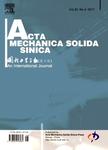HIERARCHICAL STOCHASTIC FINITE ELEMENT METHOD FOR STRUCTURAL ANALYSIS
HIERARCHICAL STOCHASTIC FINITE ELEMENT METHOD FOR STRUCTURAL ANALYSIS作者机构:The Key Lab of Engineering Disaster Prevention and Structural Safety of China Ministry of EducationSchool of Civil Engineering and ArchitectureGuangxi University
出 版 物:《Acta Mechanica Solida Sinica》 (固体力学学报(英文版))
年 卷 期:2013年第26卷第2期
页 面:189-196页
核心收录:
学科分类:02[经济学] 0202[经济学-应用经济学] 020208[经济学-统计学] 07[理学] 0805[工学-材料科学与工程(可授工学、理学学位)] 0802[工学-机械工程] 0714[理学-统计学(可授理学、经济学学位)] 070103[理学-概率论与数理统计] 0701[理学-数学] 0801[工学-力学(可授工学、理学学位)] 0702[理学-物理学]
基 金:Project supported by the National Natural Science Foundation of China (No. 51168003) the Guangxi Program of Science and Technology (Nos. 0991020Z and 2010GXNSFD169008)
主 题:hierarchical stochastic finite element method random field variational principle,Karhunen-Loeve series
摘 要:In this paper, the hierarchical approach is adopted for series representation of the stochastic nodal displacement vector using the hierarchical basis vectors, while the Karhunen- Loire series expansion technique is employed to discretize the random field into a set of random variables. A set of hierarchical basis vectors are defined to approximate the stochastic response quantities. The stochastic variational principle instead of the projection scheme is adopted to develop a hierarchical stochastic finite element method (HSFEM) for stochastic structures under stochastic loads. Simplified expressions of coefficients of governing equations and the first two statistical moments of the response quantities in the schemes of the HSFEM are developed, so that the time consumed for computation can be greatly reduced. Investigation in this paper suggests that the HSFEM yields a series of stiffness equations with similar dimensionality as the perturbation stochastic finite element method (PSFEM). Two examples are presented for numerical study on the performance of the HSFEM in elastic structural problems with stochastic Young's Modulus and external loads. Results show that the proposed method can achieve higher accuracy than the PSFEM for cases with large coefficients of variation, and yield results agreeing well with those obtained by the Monte Carlo simulation (MCS).



